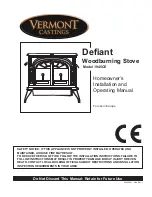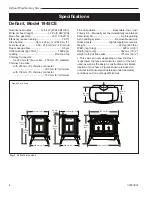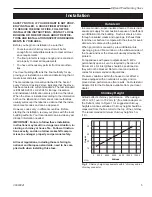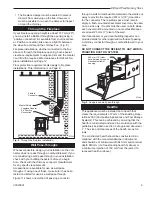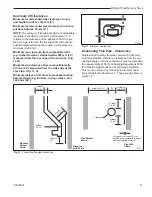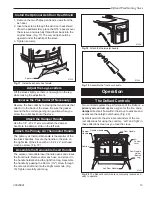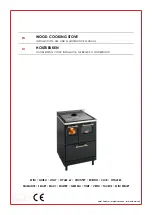
15
Defiant Woodburning Stove
30003841
To close the doors, always close the left door first. Turn
the handle in the right door to the left and up (to the
open position) and close it. Finally, push on the door as
you turn the handle to the right and down. The doors
will draw in slightly, and the handle should offer some
resistance as you turn it to the closed position.
To reduce the risk of breaking the glass, avoid striking
the glass or slamming the doors.
When you’re not using the door handle, store it in the
holder behind the left front leg of the stove. Be careful
to not drop the handle, since it is breakable.
This stove is designed to operate efficiently with
the fire doors (front doors and griddle) closed. The
firebox and ash doors should be kept closed at all
times except when refuelling or removing ashes.
Infra-Red Reflective Glass Panels
for Clear Fire Viewing
The outer surfaces of the ceramic glass panels have
an infrared-reflective coating which keeps the inner
surfaces warm. This design, along with a pre-heated
‘airwash,’ makes clear fire viewing possible at most fir-
ing levels.
Andirons Help Protect the Glass
Your stove has andirons to keep logs away from the
glass panels. The andirons are essential to maintain
clear fireviewing, and should be left permanently in
place. Since the andirons may slightly hinder refueling
through the front doors, most stove owners will prefer
the convenience of top loading through the griddle. Do
not place fuel between the andirons and the doors.
Burn Only High-Quality Wood
The Defiant is designed to burn natural wood only; do
not burn fuels other than that for which it was designed.
You’ll enjoy the best results when burning wood that
has been adequately air-dried. The wood should be
559-610 mm (22-24”) in length. Avoid burning “green”
wood that has not been properly seasoned.
Do not
burn construction materials;
they often contain
chemicals and metals that can damage the catalytic
combustor or pollute the air. Do not burn ocean drift-
wood; when it burns, the salt it absorbs will attack the
cast iron.
The best hardwood fuels include oak, maple, beech,
ash, and hickory that has been split, stacked, and air-
dried outside under cover for at least one year.
If hardwood is not available, you can burn softwoods
that include tamarack, yellow pine, white pine, East-
ern red cedar, fir, and redwood. These should also be
properly dried.
Store wood under cover to keep it dry. The longer it is
stored, the better heating and fire-viewing performance
you will enjoy. Even for short-term storage, however,
keep wood a safe distance from the heater and keep
it out of the areas around the heater used for refueling
and ash removal.
A Surface Thermometer is a Valuable
Guide to Operation
An optional surface thermometer tells you when to ad-
just the air control, and when to refuel. (Fig. 25)
ST523
Intrepid
temp readings
11/00
ST523
Fig. 25
Take temperature readings with a thermometer lo-
cated in the middle of the griddle.
For example, when the thermometer registers at least
230° C (450° F) after start-up you know that the stove
is hot enough to begin catalytic combustion and that it
may be time to close the damper. Note that the stove
will warm up much sooner than the chimney, though; a
warm chimney is the key to easy, effective stove opera-
tion. Please review the draft management information
on Page 24 to see how the size, type, and location of
your chimney will affect your stove operation. When
thermometer readings drop below 175° C (350° F) it’s
time to adjust the air control for a higher burn rate or to
reload the stove. A temperature reading over 385° C
(750° F) is a sign to cut back on the air supply to slow
the burn rate.
Use the following temperature ranges as a guide:
•
Readings in the 175°-260° C (350°-500° F) range
indicate low to medium heat output.
•
260°-315° C (500°-600° F) readings indicate me-
dium heat output.
•
Readings of 315-385° C (600°-750° F) indicate high
heat output. Operating your Defiant continuously at
griddle temperatures of 385° C (750° F) or higher
may damage the cast iron or enamel finish.
Use the Air Control Settings
that Work Best for You
No single air control setting will fit every situation. Each
installation will differ depending on the quality of the
fuel, the amount of heat desired, and how long you wish
the fire to burn; outdoor air temperature and pressure
also affect draft.
The control setting also depends on your particular
installation’s “draft,” or the force that moves air from the
stove up through the chimney. Draft is affected by such
Содержание Defiant 1945CE
Страница 34: ...34 Defiant Woodburning Stove 30003841...

